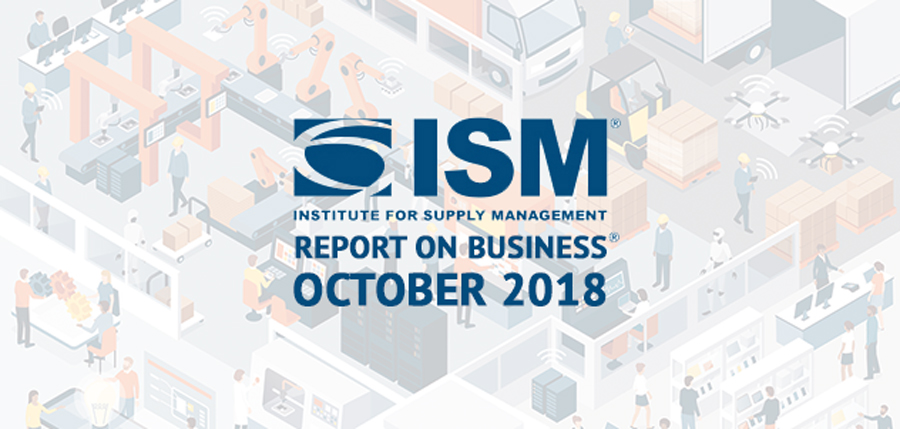The October 2018 Manufacturing ISM® Report On Business® is out, and with it has come another month of fresh insight into a sector of the economy that has experienced no shortage of tumult this year. Figures from the report show trends continuing to take shape — both good and bad — while executives from various industries weigh in on what the future may hold.
A dive into the numbers
October’s manufacturing numbers are the lowest since April’s (57.3%), with the total PMI® coming in at 57.7%, down from 59.8% in September and the year’s high of 61.3% in August. Against the trailing 12 months, October remains the second lowest in terms of overall economic standing.
The reason for this dip is prominent in key areas of the report, including new orders, production, employment, and exports. New orders fell 4.4% from September, while production dropped almost in tandem, down 4%. Employment fell 2% within the sector, along with total export orders, which tumbled 3.8% from the previous month. Despite these falls, the trend remains upward with growth, albeit slowing at year’s end.
Another significant pain point for the sector was the dramatic increase in prices, almost inexplicably the result of tariffs. Pricing was up 4.7% in October, increasing at a rapid pace. As a result, inventories fell 2.6% as suppliers have begun to combat their margin squeeze by relying on lower-cost stock.
The summation of the report continues to define the manufacturing sector as growing; however, the Report On Business® notes this growth to be slowing.
What the industry is saying
Numbers reflect the hard facts of industry trends, but perhaps more powerful is the sentiment of the executives running businesses within the manufacturing economy. The Report On Business® profiles some important comments regarding current and future outlooks regarding these trends.
On the topic of pricing and tariffs, as well as exports, there’s increasing concern about international trade — specifically the ability to source materials. An executive from the miscellaneous manufacturing sector cites the following concerns:
Mounting pressure due to pending tariffs. Bracing for delays in material from China — a rush of orders trying to race tariff implementation is flooding shipping and customs.
When it comes to orders, the industry is looking both short- and long-term. While the trend recently has been up, manufacturers recognize that we’re reaching a plateau — or worse, a cliff. This statement from the fabricated metal products sector sums up the sentiment nicely:
Orders and shipments are strong right now. Backlog for Q4 and next year are way down. Savvy customers are asking us to hold pricing on blanket orders, but material suppliers will only hold prices for a few days, which puts us in a bad spot. We’ll be spending as much as possible on capital improvements before the end of the year.
As a whole, the manufacturing industry is riding on more than two years of positive growth and demand. Will this wave continue to gain momentum, or has it crested — with a crash on the horizon? The numbers and general feeling within the industry point to rocky times ahead. However, cognizance on the part of experienced professionals means bracing for an impact and lessening the ripple events of a more uncertain economy.
